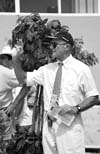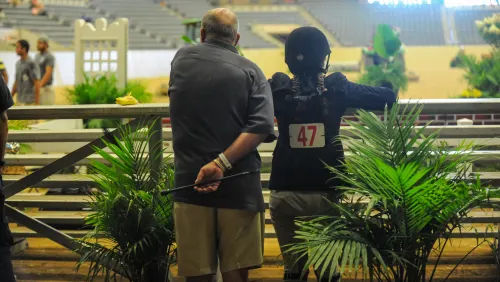 When I took over this job of U.S. chef d’equipe last spring, my mission was to attempt (and I do mean “attempt”!) to implement a comprehensive international program. Of course, I recalled that Bertalan de Nemethy had given us the absolutely best blueprint of a program for our country.
When I took over this job of U.S. chef d’equipe last spring, my mission was to attempt (and I do mean “attempt”!) to implement a comprehensive international program. Of course, I recalled that Bertalan de Nemethy had given us the absolutely best blueprint of a program for our country.
What Bert taught us was that we had to compete against the European teams, even to select our teams with them in mind. His select group would spend up to four months each summer competing in Europe. Yes, we used our own good shows to prepare for Europe, but let me make it very clear: Bert gave us the exact formula. We must maintain it, yet tailor it to today’s world and life.
The most important point of my program is to stay in the Samsung Super League, for that affords us the much-needed preparation for the Olympics, World Championships, Pan Am Games and World Cup Finals. I cannot conceive of being predictably successful in these championships without everlasting participation in the Super League.
The Super League, and Europe’s outdoor season, starts in early May on the West Coast of France, in La Baule. This was the first show of our tour No. 1–La Baule, Rome and St. Gallen (Switzerland).
Our team–Laura Kraut, Beezie Madden, Anne Kursinski, Schuyler Riley and Georgina Bloomberg–started off with a bang and won four classes (including the Nations Cup). La Baule gave us a much-needed “shot in the arm” after the Las Vegas World Cup Final and showed us that we could do it.
Our success at La Baule was a bit misleading, though. Europe wasn’t going to be all that easy in the coming months.
Still, Rome proved good for us. We ended up a very good second to a strong British team and led the Super League. But we haven’t done very well in the grand prix events on a regular basis this summer.
At St. Gallen, the Nations Cup was a big disappointment. We were leading after the first round and dropped to fourth. Unfortunately, our reputation is that we can’t stand up under pressure. We must remedy this. It’s very detrimental to our program, cause and psychology.
ADVERTISEMENT
Tour No. 2–Todd Minikus, Aaron Vale, Chris-tine Tribble, Callan Solem and Nona Garson–started at Rotterdam (the Nether-lands). Although last in the Nations Cup, against top teams pre-paring for the Euro-pean Championships, their scores made their performance look far worse than it was. And we only improved our lot slightly in the Nations Cup at Lum-men (Belgium), finishing seventh.
On to Falsterbo (Sweden), where history seemed to repeat itself in the Nations Cup (remember St. Gallen?), when we were tied for the lead after the first round and then dropped to fifth. We rarely experience Nations Cup competition at home, and the Europeans play this game every week. It’s the way they play the game. And we have to be there to learn it.
I thought the team for tour No. 3–Hickstead (England), Dublin (Ireland) and Aachen (Germany)–was as good a group as we could get: Laura Kraut, Beezie Madden, Kim Prince, McLain Ward and Jeffery Welles.
Again, we started off like gangbusters. The first day at Hickstead, McLain won the speed qualifier (Goldika) and the big table A (Oasis). We were also second and third with Anthem (Laura) and Armani (Jeff).
Of course, going into the Nations Cup, we were one of the favorites. But disaster struck when McLain and his mare fell at the double liverpools at the end. He broke his collarbone and missed the rest of Hickstead and Dublin.
Nonetheless, the three women put up a great fight to finish second, 1 point behind a strong German team.
The weekend was to get brighter, however. Laura, Kim and Beezie finished first, second and sixth in the prestigious Queen Elizabeth II Cup, and Jeffery won the historic King George V Gold Cup with the only double-clear round.
Right away we headed to Dublin, full of confidence and press clippings. After Beezie won the first big jump-off class (Authentic), and Jeffery won a very big two-phase competition (Armani), we were really the odds-on favorite to win the Nations Cup. But we settled for a tie for third with Belgium. It just wasn’t our day. Let me leave it at that.
ADVERTISEMENT
So, were do we stand today in the world of show jumping?
I would say I know a good 15 of our top riders and their horses very, very well. That’s something I set out to do. And I’d say that at the championship level, we lack experience and depth of horse/rider combinations. I know this sounds hard to believe, but it’s true. We have to keep building and competing and building and competing. It’s not an easy fix.
I visited San Patrignano, Italy, to watch the European Show Jumping Championships, which were a re-run of the Athens Olympics. The Germans are in a class by themselves–they could field two or three top teams. Most of the other European teams are in a pack, and we’re right with them. Not better.
Why is this? Because the Germans are the most intelligent, hardworking and aggressive. It’s in their genes. They’re hard as nails.
Second, they have a great horse tradition and a great horse-breeding industry. And, on a weekly basis, they have the best horse shows (even their little ones) in the world. And their location is perfect: the heart of Europe.
While I’ve always differed considerably with them in the methodology of riding and training, I have always admired their strong points enormously. I know that to consistently catch the Germans at their own game is a daunting task. But it’s why I jump out of bed every morning–to try and beat the Germans!
As Mark Phillips says to his three-day team, “There’s still a lot of work to be done!” Let’s stop talking about what we’re going to do and start doing it!














